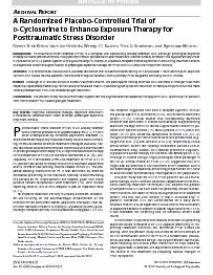A Randomized Placebo-Controlled Trial of D-Cycloserine to Enhance Exposure Therapy for Posttraumatic Stress Disorder
Background
Posttraumatic stress disorder (PTSD) is a complex and debilitating anxiety disorder, and, although prolonged exposure therapy has been proven effective, many patients remain symptomatic after treatment. In other anxiety disorders, the supplementary use of d-cycloserine (DCS), a partial agonist at the glutamatergic N-methyl-D-aspartate receptor, showed promise in enhancing treatment effects. We examined whether augmentation of prolonged exposure therapy for PTSD with DCS enhances treatment efficacy.
Methods
In a randomized, double-blind, placebo-controlled trial we administered 50 mg DCS or placebo 1 hour before each exposure session to 67 mixed trauma patients, recruited from regular referrals, with a primary PTSD diagnosis satisfying DSM-IV criteria.
Results
Although DCS did not enhance overall treatment effects, the participants having received DCS did show a stronger treatment response. Exploratory session-by-session analyses revealed that DCS yielded higher symptom reduction in those participants that had more severe pretreatment PTSD and needed longer treatment.
Conclusions
The present study found preliminary support for the augmentation of exposure therapy with DCS, specifically for patients with more severe PTSD needing longer treatment.
Geachte bezoeker,
De informatie die u nu opvraagt, kan door psychotraumanet niet aan u worden getoond. Dit kan verschillende redenen hebben,
waarvan (bescherming van het) auteursrecht de meeste voorkomende is. Wanneer het mogelijk is om u door te verwijzen naar de bron
van deze informatie, dan ziet u hier onder een link naar die plek.
Als er geen link staat, kunt u contact opnemen met de bibliotheek,
die u verder op weg kan helpen.
Met vriendelijke groet,
Het psychotraumanet-team.
In: Biological Psychiatry ISSN 0006-3223 | 71 | 11 | 962-968
https://www.biologicalpsychiatryjournal.com/article/S0006-3223(12)00212-0/pdf


